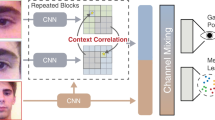Abstract
The appearance-based method for gaze estimation has great potential to work well under various conditions, but current learning-based methods ignore inferior eye images in datasets caused by poor eye region locating, occlusions and abnormal head poses. These images badly impact the accuracy of estimation. In the study, inspired by binocular vision characteristics, we propose two cooperative sub-networks, True Gaze Consistency Network (TG-Net) and Single Gaze Inconsistency Network(SG-Net) which composes TSG-Net. TG-Net and SG-Net cooperate through a residual paradigm and Informing module. More specially, TG-Net explicitly extracts the consistency of paired eyes and weights high-level features from two paired-eye images utilizing SE-Block and an artificial gaze direction, named True Gaze. SG-Net outputs residual momentums based on True Gaze for better estimation of paired eyes. Experimental results on three benchmark datasets demonstrate that the proposed method performs competitively against the existed representative CNN-Based methods. TSG-Net improves on the state-of-the-art by 22% on MPIIGaze and shows more advantages in additional analysis.









Similar content being viewed by others
References
Cazzato D, Leo M, Distante C, Voos H (2020) When i look into your eyes: a survey on computer vision contributions for human gaze estimation and tracking. Sensors 20(13):3739
Chen H, Wang Y, Xu C, Shi B, Xu C, Tian Q, Xu C (2020) Addernet: do we really need multiplications in deep learning? In: Proceedings of the IEEE/CVF conference on computer vision and pattern recognition, pp 1468–1477
Cheng Y, Lu F, Zhang X (2018) Appearance-based gaze estimation via evaluation-guided asymmetric regression. In: ECCV, pp 100–115
Chennamma H, Yuan X (2013) A survey on eye-gaze tracking techniques. arXiv:13126410
Fischer T, Jin Chang H, Demiris Y (2018) Rt-gene: real-time eye gaze estimation in natural environments. In: ECCV, pp 334–352
Hennessey C, Noureddin B, Lawrence P (2006) A single camera eye-gaze tracking system with free head motion. In: ACM symposium on eye tracking research & applications. ACM, pp 87–94
Howard A, Zhmoginov A, Chen LC, Sandler M, Zhu M (2018) Inverted residuals and linear bottlenecks: mobile networks for classification, detection and segmentation
Hu J, Shen L, Sun G (2018) Squeeze-and-excitation networks. In: CVPR, pp 7132–7141
Kaur H, Manduchi R (2020) Eyegan: gaze-preserving, mask-mediated eye image synthesis. In: The IEEE winter conference on applications of computer vision, pp 310–319
Kim J, Lee JK, Lee KM (2016) Accurate image super-resolution using very deep convolutional networks. In: CVPR
Krafka K, Khosla A, Kellnhofer P, Kannan H, Bhandarkar S, Matusik W, Torralba A (2016) Eye tracking for everyone. In: CVPR, pp 2176–2184
Krizhevsky A, Sutskever I, Hinton GE (2012) Imagenet classification with deep convolutional neural networks. In: NeurIPS, pp 1097–1105
LeCun Y, Bottou L, Bengio Y, Haffner P et al (1998) Gradient-based learning applied to document recognition. Proceedings of the IEEE 86(11):2278–2324
Lu F, Sugano Y, Okabe T, Sato Y (2014) Adaptive linear regression for appearance-based gaze estimation. IEEE TPAMI 36(10):2033–2046
Mora KAF, Monay F, Odobez JM (2014) Eyediap: a database for the development and evaluation of gaze estimation algorithms from rgb and rgb-d cameras. In: ACM symposium on eye tracking research & applications, pp 255–258
Morimoto CH, Mimica MR (2005) Eye gaze tracking techniques for interactive applications. Computer Vision and Image Understanding 98(1):4–24
Park S, Spurr A, Hilliges O (2018) Deep pictorial gaze estimation. In: ECCV, pp 721–738
Park S, Mello SD, Molchanov P, Iqbal U, Hilliges O, Kautz J (2019) Few-shot adaptive gaze estimation. In: Proceedings of the IEEE international conference on computer vision, pp 9368–9377
Ranjan R, De Mello S, Kautz J (2018) Light-weight head pose invariant gaze tracking. In: CVPRW
Simonyan K, Zisserman A (2014) Very deep convolutional networks for large-scale image recognition. arXiv:14091556
Sugano Y, Matsushita Y, Sato Y (2014) Learning-by-synthesis for appearance-based 3d gaze estimation. In: CVPR, pp 1821–1828
Tan KH, Kriegman DJ, Ahuja N (2002) Appearance-based eye gaze estimation. In: WACV. IEEE, pp 191–195
Valenti R, Sebe N, Gevers T (2011) Combining head pose and eye location information for gaze estimation. IEEE TIP 21(2):802–815
Vaswani A, Shazeer N, Parmar N, Uszkoreit J, Jones L, Gomez AN, Kaiser Ł, Polosukhin I (2017) Attention is all you need. In: NeurIPS, pp 5998–6008
Walsh T (2010) Visual fields: examination and interpretation, vol 3. Oxford University Press
Wilson AC, Roelofs R, Stern M, Srebro N, Recht B (2018) The marginal value of adaptive gradient methods in machine learning, pp 4148–4158
Witzner HD, Qiang J (2010) In the eye of the beholder: a survey of models for eyes and gaze. IEEE TPAMI 32(3):478–500
Yamazoe H, Utsumi A, Yonezawa T, Abe S (2008) Remote gaze estimation with a single camera based on facial-feature tracking without special calibration actions. In: ACM symposium on Eye tracking research & applications. ACM, pp 245–250
Yoo DH, Chung MJ (2005) A novel non-intrusive eye gaze estimation using cross-ratio under large head motion. CVIU 98(1):25–51
Zhang X, Sugano Y, Fritz M, Bulling A (2015) Appearance-based gaze estimation in the wild. In: CVPR, pp 4511–4520
Zhang X, Sugano Y, Bulling A (2017a) Everyday eye contact detection using unsupervised gaze target discovery. In: UIST
Zhang X, Sugano Y, Fritz M, Bulling A (2017) Mpiigaze: real-world dataset and deep appearance-based gaze estimation. IEEE TPAMI 41(1):162–175
Zhu Z, Ji Q (2005) Eye gaze tracking under natural head movements. CVPR, IEEE 1:918–923
Zhu Z, Ji Q, Bennett KP (2006) Nonlinear eye gaze mapping function estimation via support vector regression. ICPR, IEEE 1:1132–1135
Acknowledgements
This work was supported in part by National Science Fund of China no.61871170; The Basic Research Program of KY2017210A001; Key Laboratory of Brain Machine Collaborative Intelligence of Zhejiang Province.
Author information
Authors and Affiliations
Corresponding author
Ethics declarations
Conflicts of interest
The authors declare that they have no conflict of interest.
Rights and permissions
About this article
Cite this article
Li, J., Fei, J., Cheng, S. et al. TSG-net: a residual-based informing network for 3D Gaze estimation. Multimed Tools Appl 81, 3647–3662 (2022). https://doi.org/10.1007/s11042-021-11666-6
Received:
Revised:
Accepted:
Published:
Issue Date:
DOI: https://doi.org/10.1007/s11042-021-11666-6




